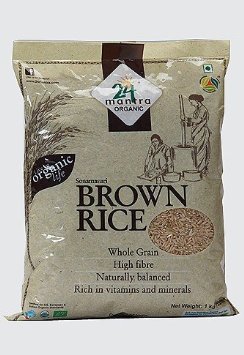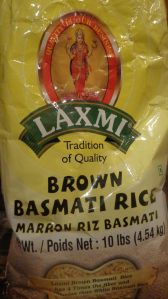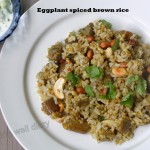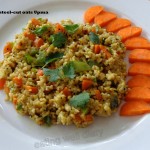20 October, 2013
Brown Rice for Everyday Meals

Switching from white rice to whole rice or brown rice is one of the most fundamental changes that can be made in a diet that is rice-based. Brown rice contains both the bran and germ in addition to the endosperm part of the grain. It is more nutritious than white rice. Since it is a complex carbohydrate or a ‘slow carb’, it will not lead to a spike in sugar level and digests slower than white rice. Brown rice contains magnesium, selenium, manganese and fibre. For more information on the full benefits, the following webpage is useful.
http://www.whfoods.com/genpage.php?tname=foodspice&dbid=128
Brown rice is more chewy than white rice and it may take some effort to make the switch from white to brown, but I recommend going cold turkey. Just do the switch and don’t turn back! Even young kids won’t complain if you don’t give them a choice. It all depends on the variety/brand of rice that we choose to eat and how well it is cooked. Try soaking before cooking the rice, read further to learn why it is good… Once you settle on the type of brown rice that is most suited for you and your family, it is easy to stick to the routine and replace all of your white rice with it.
IMPORTANT:
Soaking whole grains for at least 6 hours prior to cooking is very important to improve digestibility of many whole grains.
I cook brown rice after soaking it overnight in water. Discard the water used for soaking! This, in my opinion is the BEST WAY TO COOK BROWN RICE. The long soaking time (6-8 hours) allows for the grains to become soft and also removes the harmful enzyme inhibitors that would hinder its digestion. It helps busy families pack lunch in the morning, if it requires fresh rice.
The different varieties that I have tested:
Updated 2015: I use 24-Mantra Organic Brown Sona Masoori rice from a local Indian mart and highly recommend the brand.
pic courtesy: Amazon.com
Brown Basmati Rice
Brown basmati rice available as a 10 lb bag in the Indian store is available in 3 or 4 different brands. The one that I like the most is the Laxmi brand since it cooks easier than the other varieties and is softer in texture. After soaking over night, I use 1 and 2/3 cups of water for every 1 cup of basmati brown rice cooked in a pressure cooker. I let the cooker blow 5-6 whistles before turning off the stove. Allow the pressure cooker to cool slowly on the same electric coil/burner in order to get a nice soft texture.
The Kohinoor brand of basmati brown rice also gives grains with soft texture, but is more expensive. I have also tried the Royal brand, which although is very aromatic, dries up so that it becomes harder to chew when kept for a second meal a few hours after the first meal.
Long Grain Brown Rice
Long grain brown rice, Nishiki brand (available in Chinese stores), is the sticky variety. It cooks best after soaking in water overnight. Pressure cook with 1 1/2 cups water to a cup of rice in a pressure cooker. Allow the cooker to blow at least 7 whistles to ensure completion of cooking. The texture is softer than basmati rice but is also sticky. Ideal for yogurt rice.
Sona Masoori Brown Rice
Sona masoori brown rice is also available in the whole form in the Indian store (20 lb bag). This is the medium/short grain variety and is cheaper than the basmati variety. After soaking overnight, it requires 1 and 2/3 cups of water to 1 cup of rice, cooked in a pressure cooker. Allow 5-6 whistles. If any water remains after cooking, it can be drained or put it back in the cooker and allow a couple more whistles.
The texture is more discrete, non-sticky, not as soft as long grain. Dries up easily for a subsequent meal and is best stored in a pot kept inside a closed vessel (or pressure cooker) with some water in the vessel/cooker.
I regularly use Laxmi brand of basmati brown rice and 24-Mantra Organic sona masoori brown rice as well.
Some facts:
1. Brown rice spoils faster than white rice which is why it is more expensive than white rice. It is better not to buy in bulk from places like Costco, it may be rancid.
2. Brown rice has a lower glycemic index of around 24 compared to white rice which is 29. Among the different varieties of brown rice, basmati is supposed to contain the least amount of carbohydrates and hence has very low glycemic index. The GI of sona masoori brown rice is much higher.
3. There are concerns about higher arsenic content in brown rice. Look up my thoughts in this updated post for more information.








28 thoughts on : Brown Rice for Everyday Meals
Great start Apsara! Will follow your blog. We also try to use Brown/red rice but not on a daily basis – do you know about the difference between these? I just pick it up from our local grocery store in Bangalore. So I think I need to research more if it is the same as what you have mentioned.
Happy Blogging!
Cheers
Harini
Harini, I don’t know what red rice is, but sounds like some whole rice variety. They say any coloured rice is more nutritious than white.
Hey Apsara, We use the Lakshmi Brand Brown Basmathi regularly. However I have never been very confident about feeding brown rice to the kids. Firstly, is it easily digestible esp. with the high fiber content? Also I have heard abt the high arsenic content in brown rice. So not sure if it would be safe for kids(unless it is organic). What do you think?
Kripa, I have been feeding my kids brown rice for more than a year now. I rotate between basmati and sona masoori, now trying long-grain rice. They have not really complained about texture (of course, I don’t give them a choice!). Infact, when we eat outside, they say with wonder “the mammam is white here!”. The fibre content is ok, it in fact improves their regularity. Earlier, my daughter used to be constipated very often; now she’s ok. The arsenic content, I have heard is high in rice cultivated in the US. The ones in the Indian store is exported from India, I thought. I will check that though. thanks for your comment!
Where do you live? I’ve never seen or heard of all these brands of brown rice. I live in a very small town with limited choice of rice. And then I don’t have a pressure cooker or a gas stove. I think pressure cookers work best on Gas stoves or electric stoves with coil burners. But thank you so much for the information. Next time I visit little India in Toronto I shall look out for basmati brown rice. Thanks for sharing!
I live in a small town in the U.S but we have a store that sells Indian stuff. So, that makes it easy. And I have a convection electric stove, the pressure cooker works fine on it. I believe that the ratio of water would be the same if cooked in a pan as well. Soaking prior to cooking certainly makes the rice softer in texture.
Very helpful post. I am partial to brown basmati rice Except for risotto, I never make white rice.
Thank you. I am too! But I do use brown sona masoori rice too, since it is cheaper and rice is a staple in my house.
Pingback: A gloomy day outside, but bright within- the Liebster Award and more about myself! | Eating Well Diary
12-hr soak is ideal. =)
Thank you for the tip. These days, I soak overnight and use much less water to cook the brown rice. But the texture does become more mushy with longer soak times, it took me some time to get used to.
I talk about the phytic acid in the soak water here:
http://myholistictable.wordpress.com/how-to-eat-other-how-tos/
toward the bottom, if you’re interested in more info.
Blessings. =)
Hello Apsara, I couldn’t agree more with this! I am trying to eat only brown rice now instead of white rice. And I really like it, there is more “bite” to the rice. Great post – thank you! 😉
you’re welcome, Sylvia. Thanks for finding this old post. 🙂
Pingback: Millet Mung Pudding + Writing Process Blog Tour | Sugarfree Sweetheart
Pingback: brown rice for everyday meals- update | Eating Well Diary
Pingback: This blog is a year old! A small Raspberry ganache pie (no bake, gluten-free) and a big confession… | Eating Well Diary
Thanks for all of the info on brown rice – I am one of those having a hard time giving up my white rice 🙂
I’m glad you find this useful. Judy! Have a great weekend. 🙂
thanks for the info!
Pingback: Mixed Vegetable Brown Rice Pilaf for Diabetes Friendly Thursdays | EATING WELL DIARY
Thank you mam for the article, it do benefited me indeed…I wonder why it takes so much time to steam…Do u have any which brand is better, my fiance has some gastric ulcer problem and is Dawaat Brand good?
Brown rice takes longer time to cook than white rice. Soaking before cooking makes it softer and easier to cook. I recommend 24 Mantra Organic brand of sona masoori brown rice.
.
Pingback: Mixed Vegetable Brown Rice Pilaf for Diabetes Friendly Thursdays | The Fresh Diet
Pingback: Mixed Vegetable Brown Rice Pilaf for Diabetes Friendly Thursdays | Thefast Metabolism Diets
Pingback: Bell pepper and Lemon Brown Rice for your Lunchbox- a Meatless Monday recipe | EATING WELL DIARY
Pingback: Bell-pepper-and-lemon-brown-rice-lunchbox-recipe
Awesome post. I read your posts fairly often and you always do a good job articulating the whatever topic you’re blogging about.
Btw, I shared this on Twitter and my followers loved it.
Keep up the great work!